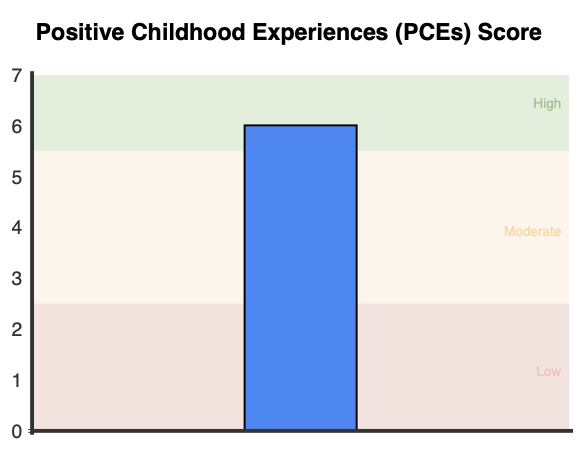The Positive Childhood Experiences (PCEs) scale is a 7-item self-report measure designed to retrospectively assess positive childhood experiences from birth to age 18 years. Developed within a developmental psychopathology framework, the PCEs scale evaluates interpersonal experiences that serve as assets and resources for developing children (Bethell et al., 2019).
Positive experiences during childhood, including nurturing and responsive caregiving, and safe and equitable environments, are associated with happy, productive, and healthy lives throughout adulthood (Bethell et al., 2019). The PCEs scale measures positive childhood experiences in family relationships – assessing the presence of safe, supportive family interactions (e.g., being able to talk about feelings with family, family standing by during difficult times, feeling safe and protected by an adult at home), social connections – evaluating positive relationships outside the immediate family (e.g., having at least two non-parent adults who took genuine interest, feeling supported by friends), and community engagement – measuring sense of belonging and participation (e.g., enjoying community traditions, feeling a sense of belonging in high school).
Example PCEs Items
For clinicians, the PCEs scale offers several distinct advantages, particularly in settings where understanding resilience factors is crucial for intervention planning. The measure is especially valuable for working with individuals who have experienced adversity, as it identifies existing strengths that can be leveraged in treatment. The PCEs scale can function as a strength-focused counterpart to adversity measures such as the Adverse Childhood Experiences (ACEs) scale, enabling a more balanced assessment of developmental influences.
In treatment planning, clients with few or no PCEs may benefit from a greater initial focus on establishing safety and trust in the therapeutic relationship before engaging in deeper trauma work. During therapy, understanding and exploring PCEs can foster hope and facilitates a strengths-based approach to meaning making and identity development. Additionally, PCEs can serve as existing strengths or resilience factors, which can be developed as internal resources for navigating trauma work in modalities such as EMDR and other trauma-focused therapies.
When using the PCEs scale in clinical practice, consider the following:
The PCEs provides a single total score where scores range from 0-7. The PCEs uses a Likert response format but only response options of “Most of the time” or “All of the time” are indicative of a positive experience being present (a score of 1) whereas all other response options represent an absence of the positive experience (a score of 0). The total score represents the sum of all positive childhood experiences endorsed, providing a comprehensive measure of protective factors that research links to enhanced resilience and better mental health outcomes even in the presence of childhood adversity.

For clinical interpretation, PCEs scores are categorised into three qualitative descriptors:

These descriptors offer clinically meaningful categorisations that facilitate interpretation and communication of results.
Upon first administration a plot is displayed showing the PCEs total score with qualitative descriptors presented in the background for ease of translation. If administered on multiple occasions, an additional plot is presented showing the total score over time.
The seven items in the PCEs scale were adapted from four subscales included in the Child and Youth Resilience Measure-28 (CYRM-28): (1) four items from the Psychological Caregiving subscale; (2) one from the Education subscale; (3) one from the Culture subscale; and (4) one from the Peer Support subscale (Bethell et al., 2019).
Principal components factor analysis confirmed that the PCEs scale has a unidimensional structure with a single eigenvalue greater than 1.0 (2.95) that explained 42.2% of variance. Factor loadings across the seven items ranged from 0.57 (“felt safe/home”) to 0.72 (“family stood by/difficult times”), indicating good factor structure (Bethell et al., 2019). The scale demonstrates good internal consistency with a Cronbach’s alpha of 0.77.
Construct validity of the PCEs scale is supported by its demonstrated associations with mental health outcomes. In the original study, Bethell et al. (2019) found that the adjusted odds of depression and/or poor mental health (D/PMH) were 72% lower (OR, 0.28; 95% CI, 0.21-0.39) for adults reporting high levels of PCEs (6-7) versus those reporting low levels (0-2). The adjusted odds were 50% lower (OR, 0.50; 95% CI, 0.36-0.69) for those reporting moderate PCEs (3-5 PCEs).
The scale also demonstrates predictive validity for relational health outcomes. Bethell et al. (2019) found that the adjusted odds that adults reported “always” on the adult-reported social and emotional support (ARSES) variable were 3.53 times (95% CI, 2.60-4.80) greater for adults with high versus low PCEs. These relationships between PCEs and adult outcomes remained stable across all levels of adverse childhood experiences (ACEs), providing strong evidence for the scale’s validity in diverse contexts of childhood adversity.
Cross-cultural validity is supported by findings from the Wisconsin Behavioral Risk Factor Survey (Bethell et al., 2019), which demonstrated that PCEs were associated with positive outcomes across diverse racial, ethnic, and socioeconomic groups.
Three distinct qualitative descriptors are presented for scores on the PCEs, providing clinically meaningful thresholds that reliably differentiate between outcome groups:
These categories demonstrate a clear dose-response relationship between PCEs and adult outcomes (Bethell et al., 2019).
Bethell, C., Jones, J., Gombojav, N., Linkenbach, J., & Sege, R. (2019). Positive childhood experiences and adult mental and relational health in a statewide sample: Associations across adverse childhood experiences levels. JAMA Pediatrics, 173(11), e193007. https://doi.org/10.1001/jamapediatrics.2019.3007
Bethell, C., Jones, J., Gombojav, N., Linkenbach, J., & Sege, R. (2019). Positive childhood experiences and adult mental and relational health in a statewide sample: Associations across adverse childhood experiences levels. JAMA Pediatrics, 173(11), e193007. https://doi.org/10.1001/jamapediatrics.2019.3007
NovoPsych’s mission is to help mental health services use psychometric science to improve client outcomes.
© 2023 Copyright – NovoPsych – All rights reserved